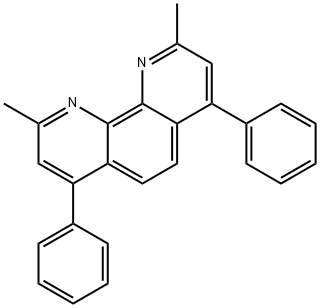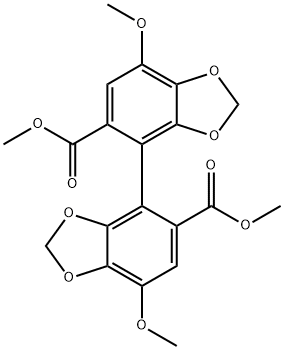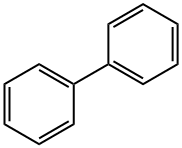Bathocuproine
Synonym(s):2,9-Dimethyl-4,7-diphenyl-1,10-phenanthroline;BCP
- CAS NO.:4733-39-5
- Empirical Formula: C26H20N2
- Molecular Weight: 360.45
- MDL number: MFCD00004972
- EINECS: 225-240-5
- SAFETY DATA SHEET (SDS)
- Update Date: 2024-12-18 14:07:02

What is Bathocuproine?
Description
Bathocuproine (BCP) is a wide-band-gap material and has a high electron affinity. When it is embedded into organic electronic devices, bathocuproine acts as an exciton-blocking barrier?which prohibits exciton diffusion process?towards the Al electrode otherwise being quenched. One of the most commonly used buffer layer between acceptor and cathode layers is?bathocuproine. The introduction of the buffer layer can greatly improve the PCE of polymer organic solar cells.?BCP is one of the most popular hole-blocking layer materials that is used in organic electronics, including perovskite solar cells.
Chemical properties
Yellow powder
The Uses of Bathocuproine
Bathocuproine is used as a reagent for the determination of copper. It acts as an exciton blocking barrier which prohibits excitons diffusion process towards the Al electrode otherwise being quenched. It is the most commonly used buffer layer between acceptor and cathode layer.
The Uses of Bathocuproine
It is used as a reagent for the determination of copper. It acts as an exciton blocking barrier which prohibits excitons diffusion process towards the Al electrode otherwise being quenched. It is the most commonly used buffer layer between acceptor and cathode layer.
General Description
TGA/DSC Lot specific scans available upon request
Purification Methods
Purify it by recrystallisation from *benzene. [Smith & Wilkins Anal Chem 25 510 1953, Beilstein 23 III/IV 2160.]
References
[1] Mao, Lingling et al. “Role of Organic Counterion in Lead- and Tin-Based Two-Dimensional Semiconducting Iodide Perovskites and Application in Planar Solar Cells.” Chemistry of Materials 28 (2016): 7781–7792.
Properties of Bathocuproine
| Melting point: | 279-283 °C(lit.) |
| Boiling point: | 482.47°C (rough estimate) |
| Density | 1.2408 (rough estimate) |
| refractive index | 1.7620 (estimate) |
| storage temp. | Sealed in dry,Room Temperature |
| solubility | Benzene (Slightly, Heated), DMSO (Slightly, Heated), Methanol (Slightly, Heated) |
| form | Powder |
| pka | 5.88±0.30(Predicted) |
| color | Yellow |
| Water Solubility | Soluble in methanol (36mg/100ml), ethanol, 2-propanol, bezene, and acetone. Partly miscible in water. |
| BRN | 306714 |
| CAS DataBase Reference | 4733-39-5(CAS DataBase Reference) |
| EPA Substance Registry System | 1,10-Phenanthroline, 2,9-dimethyl-4,7-diphenyl- (4733-39-5) |
Safety information for Bathocuproine
| Signal word | Warning |
| Pictogram(s) |
 Exclamation Mark Irritant GHS07 |
| GHS Hazard Statements |
H413:Hazardous to the aquatic environment, long-term hazard |
| Precautionary Statement Codes |
P273:Avoid release to the environment. |
Computed Descriptors for Bathocuproine
| InChIKey | STTGYIUESPWXOW-UHFFFAOYSA-N |
Bathocuproine manufacturer
Anand Agencies
New Products
(S)-3-Aminobutanenitrile hydrochloride 4-Methylphenylacetic acid N-Boc-D-alaninol N-BOC-D/L-ALANINOL Tert-butyl bis(2-chloroethyl)carbamate 3-Morpholino-1-(4-nitrophenyl)-5,6-dihydropyridin- 2(1H)-one Furan-2,5-Dicarboxylic Acid Tropic acid 1-Bromo-3,5-Di-Tert-Butylbenzene S-2-CHLORO PROPIONIC ACID ETHYL ISOCYANOACETATE 2-Bromo-1,3-Bis(Dimethylamino)Trimethinium Hexafluorophosphate 4-IODO BENZOIC ACID 3-NITRO-2-METHYL ANILINE 1-(2,4-DICHLOROPHENYL) ETHANAMINE (2-Hydroxyphenyl)acetonitrile 4-Bromopyrazole 2-(Cyanocyclohexyl)acetic acid 4-methoxy-3,5-dinitropyridine 1-(4-(aminomethyl)benzyl)urea hydrochloride 2-aminopropyl benzoate hydrochloride diethyl 2-(2-((tertbutoxycarbonyl)amino) ethyl)malonate tert-butyl 4- (ureidomethyl)benzylcarbamate Ethyl-2-chloro((4-methoxyphenyl)hydrazono)acetateRelated products of tetrahydrofuran








You may like
-
 Bathocuproine (purified by sublimation) CAS 4733-39-5View Details
Bathocuproine (purified by sublimation) CAS 4733-39-5View Details
4733-39-5 -
 Bathocuproine (BCP) extrapure AR CAS 4733-39-5View Details
Bathocuproine (BCP) extrapure AR CAS 4733-39-5View Details
4733-39-5 -
 Bathocuproine 95.00% CAS 4733-39-5View Details
Bathocuproine 95.00% CAS 4733-39-5View Details
4733-39-5 -
 Bathocuproine, GR 99%+ CAS 4733-39-5View Details
Bathocuproine, GR 99%+ CAS 4733-39-5View Details
4733-39-5 -
 Bathocuproine CAS 4733-39-5View Details
Bathocuproine CAS 4733-39-5View Details
4733-39-5 -
 BATHOCUPROINE AR CAS 4733-39-5View Details
BATHOCUPROINE AR CAS 4733-39-5View Details
4733-39-5 -
 Bathocuproine CAS 4733-39-5View Details
Bathocuproine CAS 4733-39-5View Details
4733-39-5 -
 Bathocuproine CAS 4733-39-5View Details
Bathocuproine CAS 4733-39-5View Details
4733-39-5